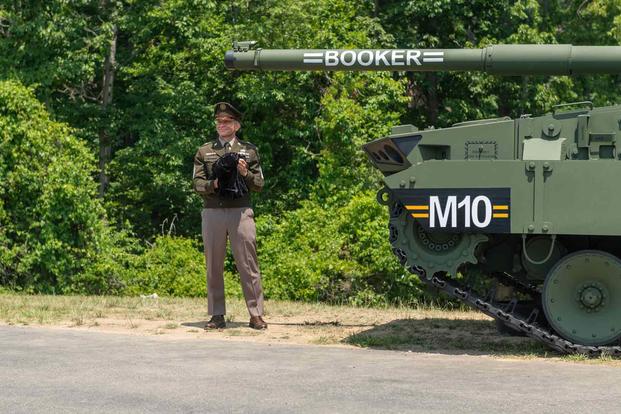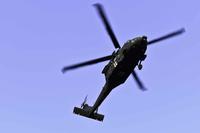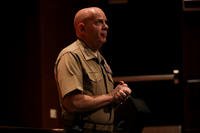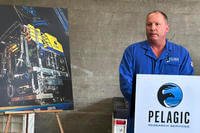Army combat veterans are excited about the new tracked fighting vehicle unveiled by the service last week, which could give more units access to powerful guns in the field. They just want to make sure the service is ready to give those troops the spare parts and training needed to make sure soldiers can use them in firefights.
"When I was a commander in combat, I don't think I ever said no to more firepower," Lt. Col. John Principe of the Army's Command and General Staff College told Military.com in a phone call.
Unveiled June 10, the M10 Booker is the first specialized armored vehicle with a tank-sized gun to join the Army in decades, a tool for wars that the service hasn't prepared for since the fall of the Soviet Union, in which big units advance across a front that could be hundreds of miles long. The past 20 years of war in Afghanistan saw combat centered on valleys that were a dozen kilometers wide, while in Iraq, combat was mostly limited to cities after the invasion.
Read Next: Space Force Could Get a Guard Force and Part-Time Guardians, If House Lawmakers Get Their Way
Four former Army combat commanders spoke to Military.com about the M10. They expressed optimism, with a common caveat that much depends on how quickly and effectively the Army puts the Booker alongside infantry.
"To be most effective, we need to integrate the M10 Booker Combat Vehicle elements with the infantry elements that are most likely to employ them. Infantry commanders need to understand the capability, trust the capability, and understand its limitations," said retired Col. William "Bill" Ostlund during a phone interview. "Either you integrate them when they're available or you'll integrate them in combat, and it's a lot harder to learn and trust a capability when rounds are flying."
Ostlund, known in the Army for his command of the 173rd's 2nd Battalion, 503rd Infantry -- "The Rock" -- during Operation Enduring Freedom VII-VIII in Kunar Province, Afghanistan, also parachuted into Iraq in 2003 to seize an airfield. For that Iraq mission, the 173rd received several armored reinforcements by plane.
"We would have traded four M1s for eight M10s as the M10s could deal with anything in Iraq," he said.
Ostlund said it will be critical that the M10 Booker is delivered to units with the parts, mechanics and cash to keep the vehicles running, along with the green light for leaders to push use of the Booker in training. The Army is also going to have to make sure the M10 can take out other tanks, using something like the SABOT round.
"Having something that looks like a tank but is not a tank-killer is a problem for commanders," he added.
Other former infantry company commanders with experience in Iraq and Afghanistan were also optimistic about the M10 Booker's capabilities. "It's supposed to add firepower to light units when they need it," said Principe, who led a platoon of Stryker infantry in combat in Iraq and commanded a company with the 10th Mountain Division in Afghanistan.
But the Army will have to prioritize maintenance needs if the vehicle is going to be helpful to units.
"My biggest gripe with mechanized anything is what happens when the s--- breaks or rolls over," said former Capt. Matthew Adkins, who served as an infantry officer and also commanded with the 10th Mountain Division in Afghanistan. "And in combat, something is always breaking or rolling over. Always."
Retired Brig. Gen. Andrew Hilmes likes the M10's capabilities. "When properly employed, the BCV will help light formations rapidly mass combat power, penetrate a prepared defense, and 'harden' themselves when performing security operations," he said during a phone interview. "I'm eager to see how it performs; it will certainly help in a large-scale combat scenario."
The M10 will carry special significance for the service because of the Army's choice to name it in honor of two soldiers who shared the surname Booker.
Staff Sgt. Stevon Booker was killed during the "Thunder Run" mission into Baghdad amid heavy fighting in 2003.
"Steve was hands down my most seasoned, experienced and competent NCO in my unit, and possibly within the armored task force," said Hilmes, who was two tanks behind Booker during the mission that would take his life. "He'd spent a lot of time as a sergeant, as a tank gunner -- he scored a 1,000 on gunnery table eight -- and had dozens of training exercises under his belt by the time he pinned staff sergeant. He was brash, confident and totally dependable."
Hilmes said that it was a terrific honor that the M10 was named after Booker and that the staff sergeant's family appreciated the gesture.
"Steve's mother lost a son, and his sister lost a brother," Hilmes said. "Nothing can replace that, but they're thrilled to see his heroism honored like this."
The combat vehicle is also named after Pvt. Robert Booker, a World War II infantryman who earned the Medal of Honor.
The Army expects the Booker to be delivered in sufficient numbers to properly train troops by late 2025 or early 2026.
The government has contracted General Dynamics to build more than 96 M10 Booker Combat Vehicles, with hopes to eventually produce over 500 (though the final number may change). Eventually, the Army plans to maintain four battalions across four light infantry divisions.
-- Adrian Bonenberger, an Army veteran and graduate of the Columbia University Graduate School of Journalism, reports for Military.com. Contact him at adrian.bonenberger@monster.com.
Related: It's Not a Light Tank: Army Unveils New Armored Combat Vehicle











